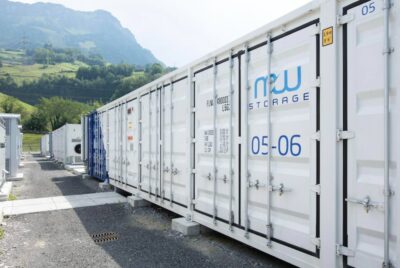

Shaping the Future of Balancing Reserves Markets: Insights from the Grünbuch Regelreserve

Germany’s Energiewende is reshaping the way our country powers itself, with the ambitious goal of reaching 80% renewable electricity by 2030. In 2024, renewables hit a record high, providing 62.7% of our electricity while cutting CO₂ emissions in half compared to 2014 (source). But as impressive as this progress is, it comes with challenges—like managing a decentralised and unpredictable grid. To tackle this, our four TSOs (50Hertz, Amprion, Tennet, TransnetBW) published the “Grünbuch Regelreserve”, a collection of ideas and proposals to modernising balancing reserves and aligning them with the needs of a renewable-powered future.
For owners of flexible assets like grid-scale BESS, this document is an important read to understand what the future might bring and be ready to adapt to changing markets. At Entrix, we see the Grünbuch as a promising blueprint for flexibility markets, contributing to integrated and responsive balancing systems across Europe. In this article, we’ll dive into its details and analyze its most relevant proposals for developing Germany’s balancing reserves.
Source: Grünbuch Regelreserve (2024)
Germany’s Energiewende is reshaping the way our country powers itself, with the ambitious goal of reaching 80% renewable electricity by 2030. In 2024, renewables hit a record high, providing 62.7% of our electricity while cutting CO₂ emissions in half compared to 2014 (source). But as impressive as this progress is, it comes with challenges—like managing a decentralised and unpredictable grid. To tackle this, our four TSOs (50Hertz, Amprion, Tennet, TransnetBW) published the “Grünbuch Regelreserve”, a collection of ideas and proposals to modernising balancing reserves and aligning them with the needs of a renewable-powered future.
For owners of flexible assets like grid-scale BESS, this document is an important read to understand what the future might bring and be ready to adapt to changing markets. At Entrix, we see the Grünbuch as a promising blueprint for flexibility markets, contributing to integrated and responsive balancing systems across Europe. In this article, we’ll dive into its details and analyze its most relevant proposals for developing Germany’s balancing reserves.
HIGHLIGHTS: What’s in Store for the Future?
Preparing for 2030 Challenges: The Grünbuch outlines how balancing reserves must adapt by 2030 to manage gigawatts of grid imbalances caused by renewable variability, forecast errors, and shifting grid dynamics. We at Entrix see this as a good opportunity for flexibility providers to anticipate and shape these shifts.
Innovating the Market:
Shorter product durations and Redispatch integration promise greater flexibility, cost savings, and new revenue streams for BESS. We at Entrix support these changes as key steps towards building a more efficient and dynamic energy market.
Background: Adapting to a Renewable Energy Dominated Grid
💡 Recap Balancing Reserves
- Frequency Containment Reserve (FCR): Instant response within 30 seconds for frequency stabilisation.
- Automatic Frequency Restoration Reserve (aFRR): Activated within five minutes to restore nominal frequency.
- Manual Frequency Restoration Reserve (mFRR): Covers imbalances lasting beyond 15 minutes.If you want to read up more on this check out our old article here.
As renewable energy sources like wind and solar replace conventional power plants, the challenge of balancing the grid has grown significantly. While renewables are crucial for our decarbonisation, their volatility introduces a new layer of complexity. Consider “PV ramps”—those spikes or dips in solar generation during sunrise and sunset. By 2030, these fluctuations could lead to grid imbalances of up to 5 GW, according to the Grünbuch. The phaseout of coal and nuclear plants has only deepened these challenges. These conventional sources once provided predictable baseload power and grid inertia, both of which are now diminishing.
The Grünbuch highlights that balancing reserve demand is driven by a web of technological, regulatory, and market factors, each contributing to the complexity of managing an increasingly decentralised and unpredictable grid.Forecasting errors remain a critical challenge. As wind farms and large-scale solar parks proliferate, even advanced prediction models and quarter-hour trading can’t always account for unexpected weather events or underestimated capacity. These errors, combined with the sheer scale of renewable installations, create a constant need for reserves.
Decentralised generation adds further complexity. Innovations like home storage systems, electric vehicle integration, and decentralised optimisation bring much-needed flexibility, but also make forecasting and reserve planning more intricate. For example, while smart meters provide detailed consumption data, turning that data into actionable insights requires sophisticated systems—like for example the Virtual Power Plant (VPP) we’re building with Flexa and Enpal 🚀.
Regulatory and market shifts compound the unpredictability. Changes like bidding-zone splits and new high-voltage direct current (HVDC) connections can increase reserve needs by demanding more granular grid management. At the same time, harmonised European policies—such as RD2.0, MARI, and PICASSO—offer a counterbalance by simplifying reserve sharing and fostering cross-border coordination.The table below taken from the Grünbuch illustrates how these factors interact: decentralised generation and HVDC connections tend to drive reserve demands higher, whereas smart grid technologies and harmonised regulations could ease them. This balance of forces reflects the inherent uncertainty in managing supply and demand during the energy transition—a challenge the Grünbuch addresses through targeted proposals.
 Grünbuch Regelreserve 2024
Grünbuch Regelreserve 2024In the following sections, we’ll have a deeper look into some of these proposals and their potential implications for BESS.
Key Proposals in the Grünbuch Regelreserve
The Grünbuch lays out some ideas & measures to adapt balancing reserves to this new landscape. In this chapter we summarise some of the key proposals described in the Grünbuch and examine their implications from the perspective of an optimiser.
Proposal 1: Shorter Product Durations – Meeting a Future Energy System’s Needs
For years, balancing reserves have operated in rigid four-hour blocks—designed in an era of conventional generation where predictability was key. Today, this structure doesn’t match the dynamic nature of renewables like solar and wind or the capabilities of flexibility assets like BESS.
The Grünbuch Regelreserve proposes shortening product durations to align with intraday trading intervals (e.g., 15 minutes). This change is expected to:
- React Faster to Volatility: Manage short-term imbalances caused by forecast errors or renewable ramps more effectively.
- Enhance Renewables Integration: Allow solar and wind assets to participate in balancing markets with durations that better match their generation profiles.
- Reduce System Costs: Lower reliance on expensive, inflexible “must-run” conventional plants during periods of high renewable generation
Entrix Perspective:
“We view this proposal as a no-brainer. These durations align perfectly with the strengths of battery systems, enabling instant responses to market signals, better optimisation, and ultimately, higher returns. By no longer having to block capacity for full 4-hour products, batteries can reduce opportunity costs and gain the flexibility to participate more dynamically in the market. Importantly, shorter product durations could open up the mFRR market for battery participation, creating a valuable new revenue stream. While tighter scheduling and increased competition introduce operational complexities, the benefits—unlocking revenue opportunities, minimising opportunity costs, and enhancing market participation—far outweigh these challenges.
Markets with shorter product durations could also benefit from reducing delays between gate closure and dispatch, as seen in some international wholesale or imbalance markets. For BESS optimisation, this would enable optimisation right until delivery, maximising the value that can be captured. However, integrating such markets with existing aFRR baseline communication frameworks presents challenges that need careful consideration.”
Proposal 2: Integration of Redispatch and Balancing Reserves
💡 Recap: Redispatch is a tool used by transmission system operators (TSOs) to prevent or resolve grid congestion. When certain transmission lines are overloaded, TSOs adjust the output of power plants, either increasing or decreasing generation, to balance power flows and maintain stability.
Redispatch 2.0 and Batteries: Current State
Redispatch 2.0 allows the distribution system operators (DSOs) the theoretical use of batteries for grid congestion management, handling both, charging and discharging to manage power flows. However, its practical application for batteries remains limited due to challenges such as operational complexities, unclear compensation mechanisms, and the need to restore battery states after Redispatch actions. These factors create economic inefficiencies and operational risks for asset operators and today a system where Redispatch possibilities are implemented, but actually not used.
Integration with Balancing Reserves
Redispatch (for congestion management) and balancing reserves (for frequency control) have evolved as separate systems in Germany. However, as renewable penetration rises and network expansion lags behind the rapid growth of wind and solar, the Grünbuch highlights the increasing interdependencies and interactions between these processes. According to the Grünbuch, integrating Redispatch and balancing reserves could significantly enhance the efficiency and effectiveness of flexibility asset utilisation.
Entrix Perspective: Opportunities and Preparedness
Ancillary services and Redispatch share the common goal of stabilizing the grid, with TSOs relying on both to manage frequency and congestion. However, when Redispatch restricts assets that are critical for providing ancillary services, it risks creating conflicts that undermine grid stability. Integrating both mechanisms is essential to avoid such conflicts, and to enable batteries to address grid congestion and frequency control simultaneously while reducing inefficiencies. To unlock this potential, a clear and fair compensation model for assets during Redispatch restrictions is crucial, ensuring real-world feasibility and maximising value creation for BESS. Entrix supports efforts for the integration of both systems as a necessary step to ensure the optimal deployment of flexibility assets and unlock new revenue streams for BESS.
Proposal 3: Expanding European Procuremen Cooperation
Balancing reserve markets cannot function in isolation. The Grünbuch emphasises that European integration is essential for improving efficiency and ensuring stability across interconnected grids. Projects like the FCR cooperation or ALPACA (”Allocation of Cross-zonal Capacity and Procurement of aFRR Cooperation Agreement”) aim at achieving this integration by fostering regional cooperation among countries such as Germany, Austria, the Czech Republic, Hungary, and Croatia, creating a more unified market for balancing reserves.
Already today, Austrian hydropower stabilises Germany’s grid during volatile periods, while Germany’s market liquidity supports Austria during low water availability. By harmonising rules for cross-border capacity reservation and optimising the use of limited transmission resources, initiatives like ALPACA not only reduces costs but also strengthens grid resilience across Europe.
Entrix Perspective:
“Overall, market harmonisation and integration are positive developments, promoting efficiency and broader opportunities for BESS deployment. However, for individual flexible assets, the impact is less clear. While increased cross regional market flexibility may reduce certain revenue opportunities, the overall effect will depend if and to what extent additional revenue streams are created.
Entrix’s focus remains on ensuring that our optimisation strategies can adapt to these changes and continue to deliver value in a more interconnected market.”
Proposal 4: Facilitating Participation for Renewables & Hybrid Sytems
The Grünbuch recognises that wind, solar, and hybrid systems (mostly PV + battery) developed under the innovation tender (InnoA), face barriers in today’s balancing markets. Complex prequalification processes and outdated baseline methodologies have hindered wind and solar from competing effectively with conventional assets. For hybrid Systems, the regulatory requirement limits BESS to charge only from the renewable asset(s) it is attached to. This limitation strongly reduces the operational flexibility of the BESS asset and its contribution to grid stability. The Grünbuch therefore proposes to simplify prequalification processes and to initiate a new discussion around baseline methodologies and to remove the no-grid charging hurdle for batteries from InnoA.
Entrix Perspective:
“Entrix especially supports the Grünbuch’s focus on facilitating hybrid systems / InnoA in participating in the balancing markets. For these systems, enabling grid charging for batteries is essential to maximising their operational flexibility, allowing them to dynamically respond to grid stability requirements.
While not explicitly mentioned in the *Grünbuch*, we believe that Virtual Power Plants (VPPs) should also play a key role in these developments. VPPs bring together distributed assets to provide grid services efficiently, increasing overall power available for grid stabilisation, which ultimately benefits everyone. Together with Enpal & Flexa Entrix has build such a VPP to leverage the full potential of decentralised flexible assets. Allowing and prequalifying VPPs as a contributor to the balancing market will unlock further potential of decentralised Systems and enhance grid stability.”
Proposal 5: A Look into Passive Balancing
Another proposal the Grünbuch discusses is the addition of passive balancing as a complement to active balancing services (FCR, aFRR, mFRR). Passive balancing means BRPs are encouraged to respond to imbalance settlement price signals and actively go into imbalance to stabilise the grid (and no longer need to follow the national laws to minimise imbalance within in their balancing groups). This could unlock distributed flexibility and enhance reserve management but would come with significant challenges. Issues like system state visibility (e.g. on how much passive balancing is happening) and the need for reliable and up-to-date price data would need to be adressed. Further analysis and discussions with regulators, market participants, and international stakeholders are necessary before this concept would be able to be implemented.
Entrix Perspective:
“Entrix finds the proposal for passive balancing particularly compelling, as it mirrors strategies like Net Imbalance Volume (NIV) chasing as seen in the UK electricity market where it is a lucrative revenue stream for BESS. In such systems, participants can adjust their behaviour to benefit from imbalance prices by predicting system imbalances, creating both, revenue opportunities and enhanced grid support.”
Summary
The Grünbuch Regelreserve is a critical puzzle piece in Germany’s energy transition, laying out a good foundation for modernising our balancing reserves. It highlights the urgency of adapting to a grid powered by renewables and also depicts the opportunities which most of these proposals will create for flexible assets like BESS. The balancing reserve market will continuously evolve with the ongoing energy transition, and the proposed changes by the Grünbuch are set to enhance energy stability.
Wondering how these changes might impact your BESS project? Let’s talk! Entrix is here to guide you, and leverages advanced optimisation strategies to help you harvest the full potential of your assets. Our experts are available to provide the insights and support you need. Get in touch with us today or directly book a meeting with us.
Let’s build the energy future together. 🚀





